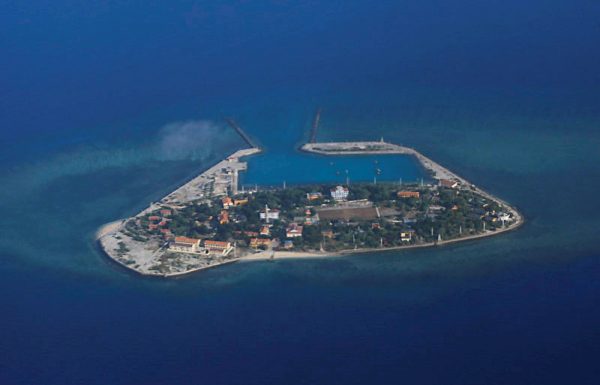A report published in the Proceedings of the National Academy of Sciences in early June 2017 confirms this observation, concluding that marine reserves are capable of mitigating and promoting climate change adaptation. At the same time, they stand extremely vulnerable to climate-induced sea warming.
While most countries have already put some marine protection measures in place, the management of shared marine environments — especially in disputed areas like the South China Sea — is lacking. A recent study published in March 2017 shows that 40 per cent of coral reefs in the Pratas Islands (also known as the Dongsha Atoll) in the northern parts of the South China Sea were bleached due to a rise in sea surface temperature during the El Niño in June 2015.
This climate-induced phenomenon is unseen in the last 40 years and has become visible in parts of the South China Sea. Regional mechanisms for the protection and management of this shared marine environment need to be strengthened, despite conflicting jurisdictional and territorial claims.
The cooperation on marine protection and conservation in the region is at the same time a fulfilment of environmental obligations and a strategy to manage tensions in the South China Sea. The cooperation of states bordering enclosed or semi-enclosed seas, under which the South China Sea is categorised, is called for in Article 123 of the United Nations Convention on the Law of the Sea (UNCLOS).
While UNCLOS provides the legal basis for regional marine cooperation, countries in Southeast Asia had already begun collaborating before signing the Convention in 1982. In 1981, Indonesia, Malaysia, the Philippines and Thailand adopted the United Nations Environment Programme (UNEP) led Action Plan for the Protection and Development of the Marine and Coastal Areas of the East Asian Region. The Coordinating Body of the Seas of East Asia was established to provide policy and financial support to the initiative. Numerous other cooperation initiatives have since sprung up.
The South China Sea dispute provides additional impetus for marine protection cooperation in the region. Forging partnerships on less politically-sensitive issues like marine protection and scientific research will open doors for dialogues and confidence building measures among concerned states. Indonesia has taken the lead in materialising this concept by organising the Workshop on Managing Potential Conflict in the South China Sea (WMP-SCS) since 1990.
The topics discussed in the workshops are mostly technical, such as tides and sea level change in the South China Sea, as well as the establishment of marine databases. The most recent workshop in 2016 deliberated on the establishment of an information hub for the WMP-SCS and joint development in the South China Sea.
At the ASEAN level, the need to strengthen regional cooperation on the protection and management of marine and coastal environments is called for in the Hanoi Plan of Action. Subsequent initiatives such as the ASEAN Working Group on Coastal and Marine Environments and the ASEAN Working Group on Climate Change are in place to address marine and coastal cooperation, as well as larger climate change issues. ASEAN Member States have also designated Marine Protected Areas (MPAs) within their own territories.
But despite various multilateral cooperation measures for marine protection, there is no overarching regional convention or institution governing the management of the shared marine environment. Existing mechanisms function mostly to establish norms and capacity building platforms. They rely on individual states to voluntarily implement the regional initiatives within their national boundaries. While this arrangement may work for now, pressing climate change issues may necessitate increased cooperation in disputed areas of the South China Sea.
In as much as marine environment cooperation has been useful in building communications among concerned states, the South China Sea issues have unfortunately hampered the zoning of the Spratlys as an MPA thus far. The apprehension towards establishing collaborative marine environment management in the disputed areas may pose a bigger challenge — especially if incidents requiring a response, such as the ramming of Indonesia’s Raja Ampat’s coral reefs by a British-owned cruise ship in March this year, take place there.
The absence of collectively-agreed regional regulations and response mechanisms for habitats and resources in transboundary waters would likely jeopardise national climate adaptation efforts aimed at contributing to the resilience of the regional marine environment in the first place.
This issue is becoming even more pressing now that US President Donald Trump has pulled the United States out of the Paris Agreement. Although the exit will only take practical effect in four years’ time, the US retreat provides all the more reason for the region to step up their own efforts to fight climate change and protect their shared marine environment.
An informal national consultation conducted by the UNEP/GEF Project revealed that country representatives were of the view that existing mechanisms are inadequate to tackle transboundary environmental issues in the South China Sea. They believed a legally-binding agreement is needed to strengthen regional inter-governmental cooperation.
Calls for a dedicated inter-governmental regional institution with a mandate and authority to operate international instruments and respond to transboundary marine challenges have been made over the years. With increasing climate pressure on marine habitats in the South China Sea and the US withdrawal from international climate obligations, it is time to enhance regional marine environmental protection and re-examine these options more closely.
Margareth Sembiring is a Senior Analyst at the Centre for Non-Traditional Security, S. Rajaratnam School of International Studies (RSIS), Nanyang Technological University, Singapore.
This article was first posted here on RSIS.

